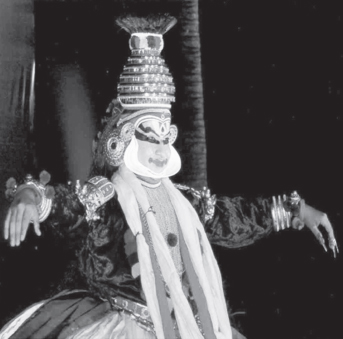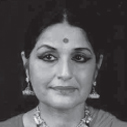Kathakali is the story dance from the southern state of Kerala. Kathakali literally means “Katha” (story) and “Kali” means a dance or a performance. It is a composite art where different actor-dancers take different roles. The stories are usually from the Indian epics Ramayana and Mahabharata. Kathakali is a very majestic art and when you see the costumes you realise how much thought and aesthetic values have gone into the making of this art. The entire idea is of ‘total theatre’ where there is acting, music – both vocal and instrumental and also the colours, psychology and costumes playing roles.
Rituals of the dance
A performance starts by lighting of the ceremonial lamp. It has just two wicks – one wick is towards the audience and the other towards the stage. It signifies that the light of knowledge must spread not only to the actors but also to the audience. And what is the message? The message is very simple. It is “the victory of good over evil. Kathakali can be described as the “theatre of imagination” where demons and good human beings clash in the realm of imagination, where the good human beings are eventually victorious.
Aesthetics of the dance
Kathakali make-up is the most complicated and the most colourful of all the make-up in the Indian classical dance styles. The make-up is called aharya-abhinaya and it follows the colour-psychology.
The characters are divided into certain broad-based groups. The uttama characters are the lofty characters, the madhyama characters are the middling characters and the adhama characters are the lowly characters. Every character has its own colour combination.
For instance, when green base is applied on the face which is called the pachha make-up, it is meant for the good of high sort of characters. The middling characters have a knife-like pattern katti pained on the cheek. The lowly sort of characters, the thorough rascals are called the beard or tadi veshams and they have red and black predominating them. The cheek is outlined by a white outline which is called chutti and which is made up of strips of cloth which are bound together by a paste made up of rice flour and lime.
A traditional Kathakali performance starts late in the evening by playing the orchestra which is considered to be very auspicious.. It also announces to the villagers around that a performance is going to take place. The orchestra is very traditional and it has not been changed for almost three centuries. The lead singer has a metal disc in his hands which is called chengala. There is the secondary singer who has heavy cymbals in his hands which are called yelatalam. The cylindrical drum, the chenda, is played by two sticks. The maddalam, which is a very ancient percussion instrument, is played by adding some coating on the fingers of the right hand in order to give resonance. The mode of singing is Sopana Sangitam which is indigenous to Kerala.
Dance postures
The position of foot is very interesting and unique in Kathakali. The foot is placed on the ground not flat but on the outer edge of the sole. This gives the necessary spring in the walk. The legs provide the solid base for the billowing skirts. It is the waist which acts as the pivot for the torso to perform the full movements.
Another very noteworthy tradition of Kathakali is the “curtain look.” Before every character makes an entry a curtain is held up and to the sounding of the drums it is slowly lowered to reveal the character. It is by the manner in which the curtain is agitated and lowered that the audience would come to know the type of character which is entering e.g. a gentle one or a demonic one etc.
- Pachha – The sattvika characters e.g. Gods like Rama, Krishna, (green base) and great heroes like Arjuna, Nala etc.
- Katti – The rajasika characters e.g. Ravana, Duryodhana etc. (green base) These are basically courageous people but they have an evil streak in their character resulting in the katti like red (knife) pattern on their cheeks.
- Tadi – The tamasika or lowly characters.
- Red beard – Evil character like Bakasura.
- White beard-Low born characters who are saintly e.g. Hanumana
- Black beard-Jungle folk and very low beings like hunters etc.
- Minukku – Shining make-up for women characters, sages, Brahmins etc.
- Kari – Black make-up for low females like demonesses, huntresses etc.
Historically, Kathakali is the end product of a long line of theatrical practices. The germs of Kathakali are to be found in the Kutiyattam, the Sanskrit drama which has been the preserve of the Chakyar Brahmin community for almost 2000 years. There are references to be found in the southern epic — Shilappadikaram which describes a dance that a Chakyar presented in the honour of the victorious king. The present form of Kutiyattam was finalised in 1000 A.D. Together with the Chakyar’s art flourished Nangyar Kuttu performed by women. In the 16th century we come to the next phase in the development in the Krishnattam which presents the Krishna cycle in eight days. Later in the 17th century developed the Ramanattam which presented the Rama cycle. It is Ramanattam, which is no more practiced, which resulted in Kathakali.


